In recent years, the Internet of Things technology has developed rapidly, and the atmosphere of the Internet of Things has gradually emerged. However, with the increase in the number of IoT devices, security issues have become one of the toughest issues in the industry. Therefore, key technologies such as big data and cloud computing have become the top priority for software platform vendors to open the door to the Internet of Things.
It is reported that by 2015, IoT equipment will grow from 3.8 billion to 4.9 billion. Some people think that the future will become the era of hackers. Faced with such pressure, the industry must start to develop an efficient and secure open platform. As the leading Internet system software provider, Wind River is working hard to create a complete IoT ecosystem to accelerate the popularity of hardware devices in the public.
To overcome the bottleneck of the Internet of Things, Wind River aims to build a security platform
For the IoT software platform, connectivity, manageability and security are the three major focuses of the Internet of Things. This is also the challenge and bottleneck encountered by IoT vendors. Su Jianhao, Manager of the Internet of Things Program for Wind River Asia Pacific, said that in the era of the Internet of Things, devices must be deployed in many places, and the stability, security, and subsequent software upgrades of the transmission are challenges. Moreover, many hardware vendors and operators are seriously lacking in security concepts and are at high risk of being attacked by hackers.
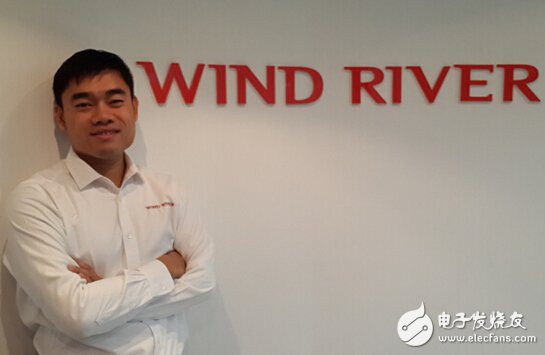
Su Jianhao, Manager of the Internet of Things Program, Wind River Asia Pacific
In addition, when talking about Wind River's solution for the Internet of Things, Su Jianhao pointed out that the main factors of Fenghe's success are the following three points:
First of all, the IoT device itself needs to have security protection. Our doors have integrated the industry's Trusted Platform Module (TPM) hardware and software to provide secure boot, protect file integrity and provide a secure storage environment. Why is this important? Because the intelligent gateway is an important infrastructure in the Internet of Things, the key factor in adopting this device is “trustâ€. You will not use any device that you do not trust; that is, what we usually call is subject to security authentication and authorization. This situation is particularly applicable to smart meters, medical equipment, avionics, and the like. Device security protection is prevention that is modified to ensure that it performs the work that was supposed to be performed.
The second is security management, which is mainly to monitor the use of equipment and system maintenance updates. It is possible to remotely authenticate the management server in the background, not only to ensure that the connected terminal is authenticated, but also to identify whether the software update instructions are authentic. Security package updates ensure that the software being downloaded to the device is secure.
Finally, the protection of the data. Role Access Control (RBAC) ensures that the device that the application is accessing has the correct permissions and priorities, while ensuring that the entire device is not interrupted or tampered with during execution.
In addition, Wind River launched VxWorks 7 earlier this year to provide advanced security features that effectively protect IoT devices, data and intellectual property. Security Profile for VxWorks provides full protection for connected devices, ranging from startup, operation, data transfer, and shutdown. It also effectively protects intellectual property and prevents plagiarism and deciphering through reverse engineering.
Promote the standardization of the Internet of Things and realize the security of the Internet of Things
At present, there are a large number of companies in the industry, and software platform companies are not a minority, but they have not formed a standard system. Su Jianhao believes that the standardization of the Internet of Things is a worthwhile direction. Since the Internet of Things covers a wide range of different industries, it is difficult to have a unified standard in the short term, but how to use the existing standard technology to solve the Internet of Things. The problem will be the goal of the Wind River software platform. The scale of the Internet of Things market continues to expand, and the challenges associated with so many networked smart devices have brought many challenges. Device management, intelligent connectivity, and security are all issues that must be considered in the development of the Internet of Things. Sex is the most important. Wind River introduces the Wind River Intelligent Device Platform (IDP) as a software development platform, a scalable, sustainable, and highly secure solution that simplifies the development, integration, and deployment of IoT gateways. The biggest advantage of IDP is its high real-time performance, and the importance of security issues from the lowest level of architecture, so it is extremely reliable.
IDP is built on Wind River's standardized, fully tested operating systems and development tools, including device security, intelligent connectivity, and rich network options and device management capabilities. Integrating the existing mature technology standards in the industry into the IDP software development platform is the greatest contribution of Wind River to the realization of the Internet of Things.
Following the trend of the software platform, Fenghe actively deployed the Internet of Things.
Due to the rise of the Internet of Things, the demand for middleware in various industries has increased, and the demand for end-to-end management and maintenance has increased. The operating system alone has been unable to meet such requirements, so the demand for end-to-end software as a whole is increasing. It is a new opportunity for the Internet of Things to bring to Wind River and other embedded software companies. In the future, the development trend of the Internet of Things software platform will be the main trend with a complete ecosystem and a complete solution from the client to the cloud.
The historical process of the development of the Internet of Things is: equipment can not be connected to the network, network equipment can provide data analysis services, and then integrated to create new revenue and business models. At this stage, most IoT companies have begun to deploy a large number of connected devices, but to the cloud infrastructure, remote monitoring, remote system updates, remote device management and data analysis, many complex applications are new IoT software platforms. Challenges, but these challenges are also the direction in which software platforms can evolve.
Su Jianhao pointed out that Wind River will actively deploy the Internet of Things market in the future, providing manageability, security and connectivity to meet a wide range of applications in the entire industry ecosystem. This is a strategic goal. In the Chinese market, Wind River will focus on three areas of rail transit, smart energy and smart buildings.
Improving security is the premise of the development of the Internet of Things. Therefore, hardware companies such as software platform vendors and smart homes and wearable devices must make every effort to improve product technology and provide users with a benign experience to create an Internet of Things security ecosystem. ring.
——Electronic enthusiasts original, please indicate the source!
Metal Core PCB , MCPCB Manufacturing Service
Overview of Metal Core PCB
Metal Core PCB, The Printed Circuit Boards good thermal management solutions.
Metal core PCB (MCPCB), also known as heat sensitive PCB, insulated metal substrates (IMS PCB), Metal PCB, Metal Base PCB, Metal Backed PCB, Metal Clad PCB, etc., are designed to provide good thermal management, using metal substrates as circuit boards for radiator parts of circuit boards. These metal materials have high thermal conductivity. Aluminum is the most economical choice because it has good heat conduction and heat dissipation capacity and is cheaper than copper and steel. However, in order to adapt to different use scenarios, people choose different materials. Base metals in MCPCB are used as substitutes for FR4 or CEM3 boards. They radiate heat from key panel components to less important areas, such as metal radiator backings or metal cores. With the latest development of high power LED, the demand for MCPCB has exploded.
MCPCB is mostly single-sided IMS, metal core PCB manufacturer can also produce double-sided MCPCB, sometimes multi-layer IMS PCB and Metal Core PCB Prototype according to need. They have very advanced and perfect metal core PCB Manufacturing process. Whichever MCPCB is chosen, the heat dissipation capability should be taken into account when choosing the thickness of base material and copper. The thermal conductivity is expressed in W/mK. The value of standard aluminium sheet is 1.0 W/mK, but other options may be 2.0, 3.0 or even 5.0 W/mK.
Most MCPCB surface treatments use HASL LF. Without fine spacing elements and BGA, HASL LF may be the most suitable finish for power LED components. However, nothing prevents us from proposing all other surface treatments; OSP, ENIG, Chem Tin or Silver for IMS applications.
Metal Core PCB for LEDs
Thermal Management PCBs are necessary for high power LED applications due to the amount of heat that LEDs generate. The bare board is the real estate that sustains electronic components such as LEDs. PCBs containing a metal core dissipate heat in LED applications. Furthermore, the MCPCB provides a much lower thermal resistance for light emitting diode applications.
The LED on the metal core Printed Circuit Board (MCPCB) is designed to provide high power output in compact packaging. Each LED package contains an LED welded to MCPCB. These LEDs are very suitable for OEM or custom applications; therefore, they should not be used for home lighting.
Metal Core PCB Design Specifications
Metal Core PCB designers always focus on price and manufacturability. However, you can rest assured that we have experienced engineers who have been engaged in DFM inspection for many years, and provide you with suggestions for choosing the best materials.
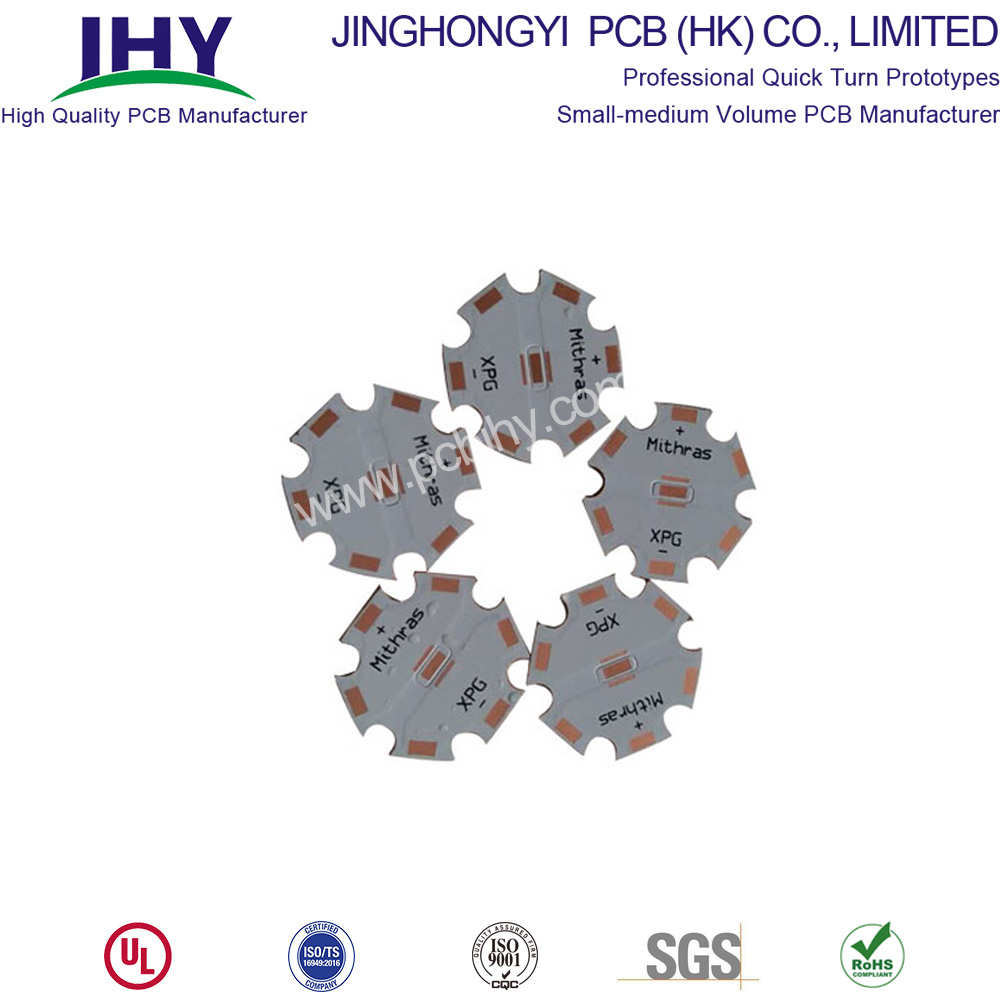
Detailed Introduction of Metal Core PCB
Conventional PCB use FR4 epoxy glass-based material on both sides of a board. However, with the growing popularity of light-emitting diode or LED technology, metal core printed circuit board or MCPCB are being deployed to deal with the increased heat LEDs generate.
Today, metal core PCB are finding greater numbers of applications in the automobile industry, traffic light signal technology, in commercial buildings, shopping malls, and even inside homes.
MCPCB use either an aluminum or copper core with the bottom side of the board serving as the heat sink. MCPCB are also used to dissipate heat in intense power-generating analog circuitry.
Metal core PCB are connected through mounting holes and screws through a box build's chassis. In this arrangement, heat is not only dissipated through the metal core, but it is also transmitted to the chassis. Hence, an LED or analog device-populated board has a considerably larger surface finish for the purpose of dissipating that heat.
But here's a word of caution about using MCPCB – actually two things to be cautious about.
- One, you need to know that making an MCPCB is complex and complicated because a metal layer is laminated with FR4, a glass-base material. Therefore, the chemistry for lamination is different during board fabrication. There is a fair possibility that there would be voids underneath the lamination, if it is not bonded properly.
- Two, a fixture to dissipate the heat from the metal core needs to be carefully defined and designed. Both these concerns demand experience.

At JHYPCB, we've been doing this for a long time, as one of professional MCPCB/ Aluminum PCB manufacturers from ShenZhen, China. We can produce metal core PCB Prototype or aluminum PCB prototyping, aluminium PCB Board for led, No Quantity Requirements, and can successfully guide you through your next MCPCB project. We have worked with over half a dozen LED manufacturers over ten years and have seen enormous amounts of different applications using MCPCB.
Choose us to provide PCB manufacturing services for you. Contact us immediately.
How Do Metal Core Circuit Boards Differ From FR4 Boards?

The dielectric material`s thermal conductivity is measured in Watts per meter, Kelvin (W/mK.) A 2.0W rating is fairly common; such material is approximately 6x-7x as thermally conductive as FR4. Best practice is to keep the dielectric layer as thin as possible. Doing so creates the shortest possible path from the heat source to the metal backing plate which is many times more thermally conductive than the dielectric material. Most of the materials come in a very limited range of thicknesses anyway, usually between .003" and .006". You won`t have all that much opportunity to specify something thicker that could diminish the effectiveness of the material at performing its thermal transfer function.
The metal backing plate used on the bottom side is the thickest element in the structure. It is available in several different thicknesses but it is best to use one of the three most common (1.0mm, 1.5mm, and 3.2mm) because they are the easiest to purchase without delays. The metal layer adds rigidity, keeps the circuit flat, and adds enough thickness so that the MCPCB can use the same mounting hardware that would be used for any other standard thickness circuit board. The metal plate side of the board does not receive any surface finish or soldermask.
Metal Core PCB Vs. Fr4 PCB Comparison
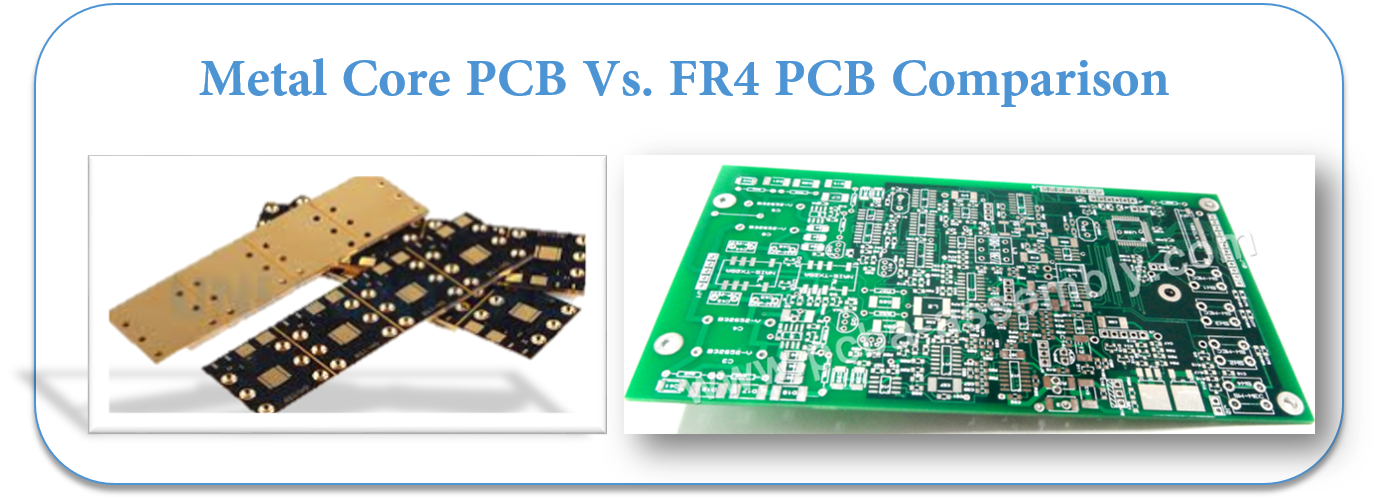
- Conductivity: FR4 has low thermal conductivity, typically around 0.3W, while MCPCB has higher thermal conductivity, ranging from 1.0W-4.0W, most commonly around 2.0W.
- Plated Through Holes: FR4 PCB typically uses plated through holes. Through hole components possible if required. In MCPCB, plated through holes are not available for 1-layer PCB. All components are surface-mounted.
- Thermal Relief: Thermal relief in FR4 PCB typically involves vias for heat transfer. Longer drill cycle, adds many processes. MCPCB materials provide their own thermal relief. Via drilling, deposition, and plating processes are eliminated.
- Solder Mask: FR4 PCB solder mask is typically dark colors (green, red, blue, black.) Usually applied top and bottom. MCPCB solder mask are almost exclusively white for LED boards. Applied to top only.
- Thickness: FR4 PCB has a wide range of thicknesses available using various material combinations and layer counts. MCPCB thickness variation is limited by available backing plate thicknesses and dielectric sheet thicknesses.
- Machining Process: FR4 PCB uses standard machining practices (drilling, routing, v-scoring, countersink, counterbore) while MCPCB uses the same machining as FR4, except that v-score must use diamond coated saw blades for the added strain from cutting into metal.
Metal Core PCB Material
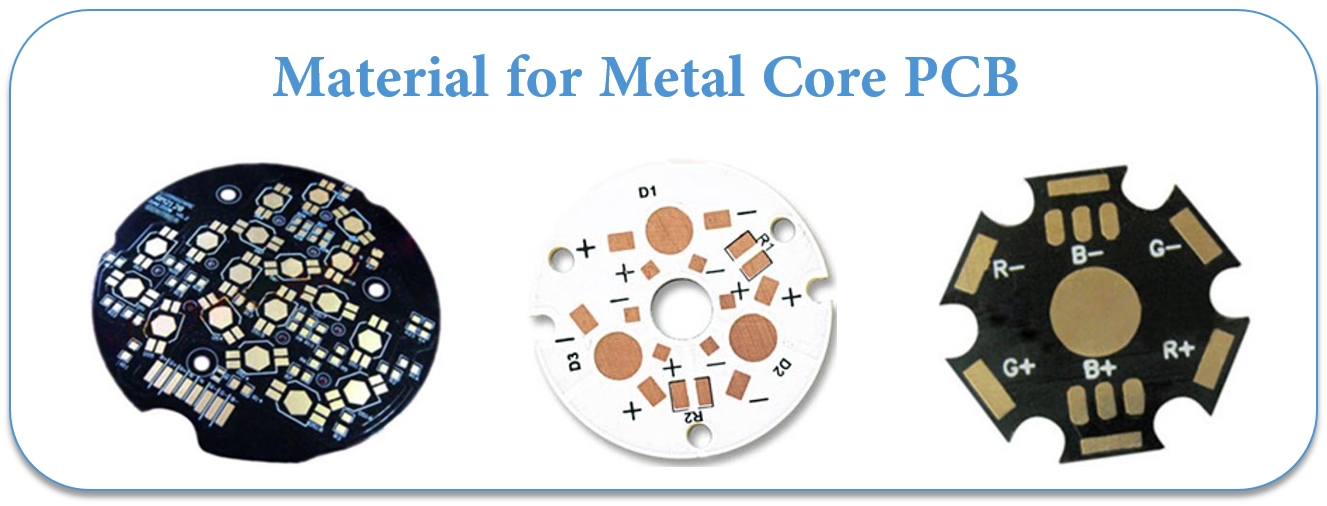
Metal Core PCB means the core (base) material for PCB is the metal, not the normal FR4/CEM1-3, etc. and currently the most common metal used for MCPCB manufacturer are Aluminum, Copper and steel alloy. Aluminum has good heat transferring and dissipation ability, but yet relatively cheaper; copper has even better performance but relatively more expensive, and steel can be divided into normal steel and stainless steel. It more rigid than both aluminum and copper, but thermal conductivity is lower than them too. People will choose their own base/core material according to their different application.
1. Aluminum PCB
Aluminum PCB , also, it is called Aluminium PCB, metal core PCB, MCPCB, IMS(Insulated metal substracte).
Aluminum PCB have 3 parts:
- Circuit Layer (Copper Layer)
- Dielectric Layer(Insulated Layer)
- Substrate Layer(Metal layer)
Aluminum Clad PCB
Available as 1 layer Non-Plated Through Hole (single sided), And 2+ layer Plated through Hole. Ideal application for LED lighting, power supply solutions. Aluminium Clad Benefits Include:
- Lower operating temperature.
- Reduce printed circuit board size.
- Increase power density.
- Extend the life of dies.
- Reduce the number of interconnects.
- Improve product thermal and mechanical performance.
- Combine power and control.
- Improve product durability.
- Enable better use of surface mount technology.
- Expedite heat sinks and other mounting hardware.
- Replace fragile ceramic substrates with greater mechanical durability
About Price:
- Price is based on the requirement of LED PCB
- PCB thickness: 0.6 – 3.0mm, always thickness more ,price higher
- Thermal conductivity: 1.0 – 10 W/m.k , thermal conductivity higher, price higher
- Material factory: Bergquist, Laird ETC, made in US factory that is more expensive than China.
2. Copper Core PCB
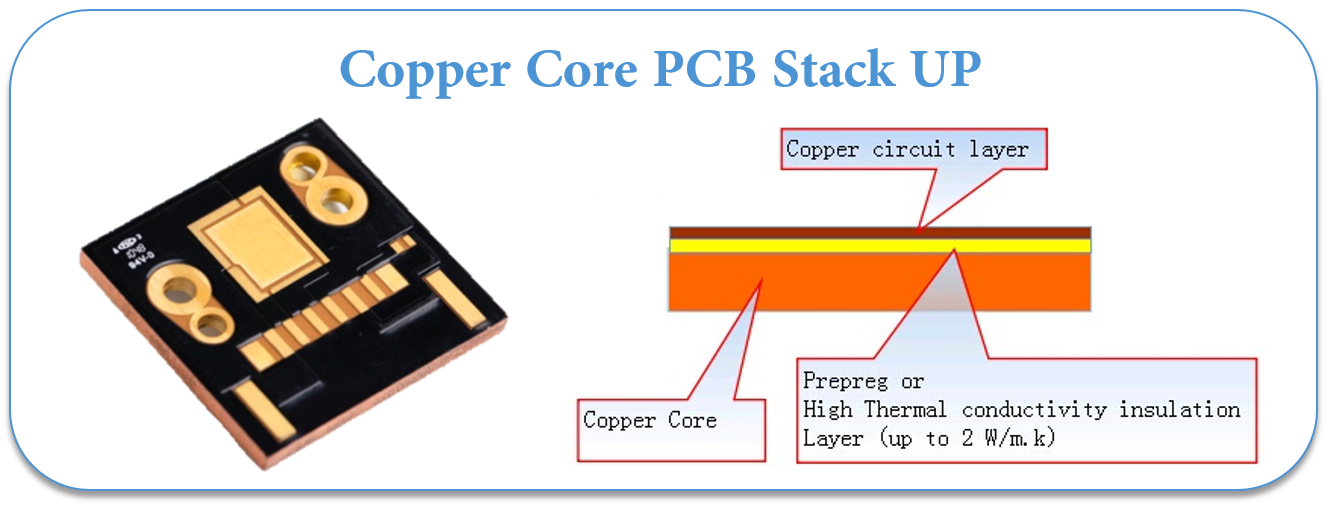
Copper core PCB is a copper substrate + Insulated layer + copper
Copper core PCB is a copper substrate + Insulated layer + copper circuits layer PCB, also, it is called copper substrate pcb, copper based pcb, copper clad pcb.
As a MCPCB manufacturer, we made various Copper core PCB for customers, Which used for High Power LED lighter ( 1000W+ ) and power supply.
In LED field, there are 4 types of Copper based Circuit Board.
COB Copper PCB(Chip on Board copper PCB)
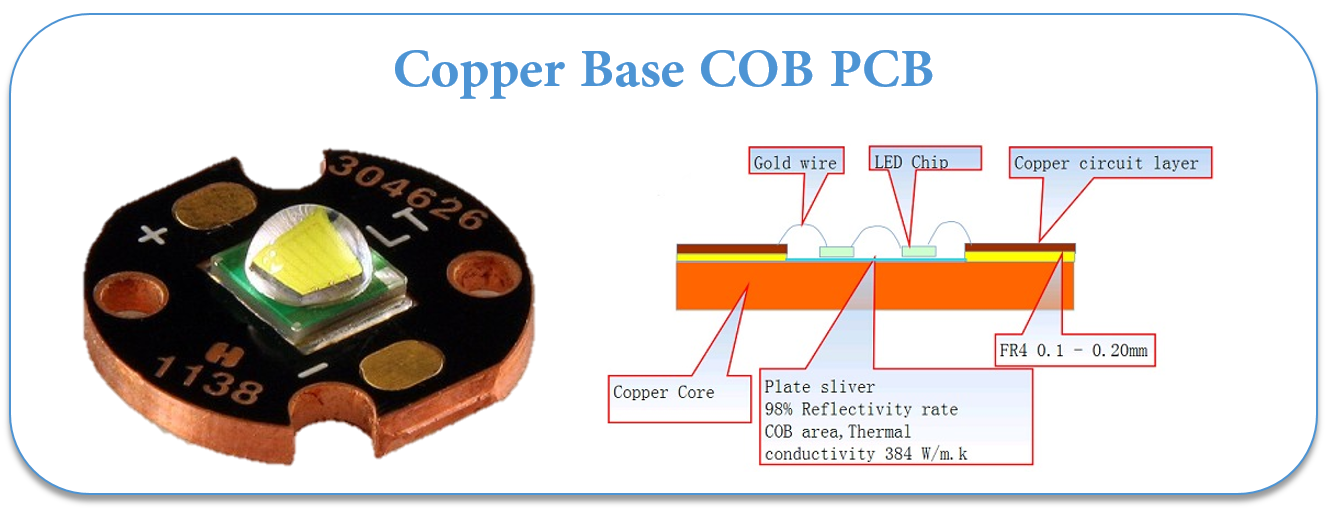
Direct thermal path, no dielectric layer under the thermal path pad.
Direct thermal path, no dielectric layer,Aluminum-copper pcb.
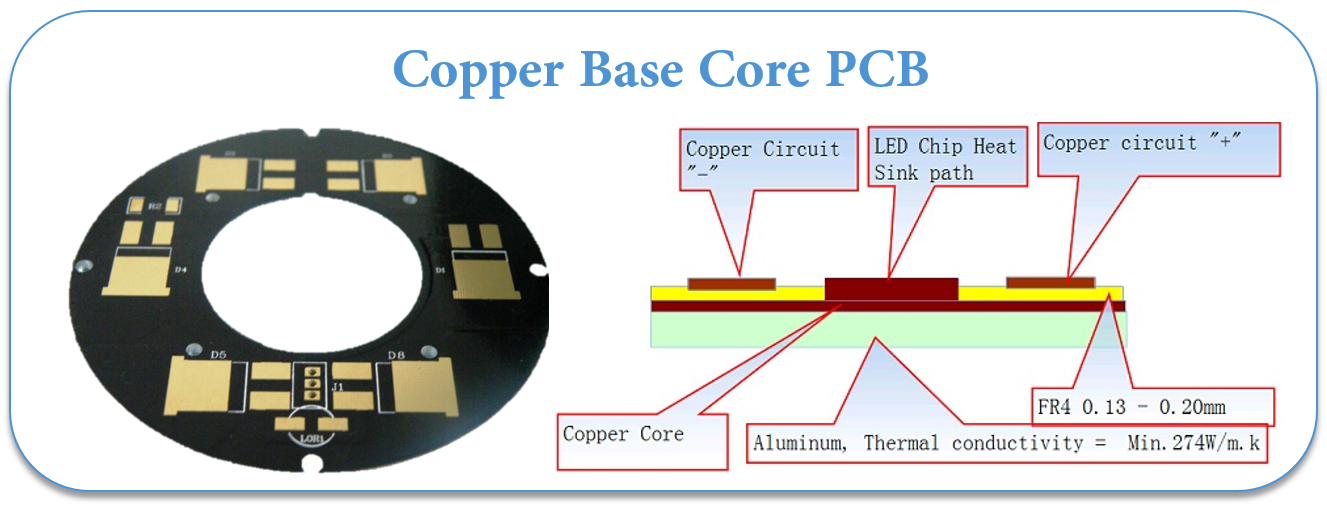
3. Iron Based PCB
The iron-based PCB use material for the base is from special steel, silicon steel and ect in stand of FR4 or CEM1 and can dissipate heat away from critical board components and to less crucial areas such as metallic core or the metal heatsink backing.
China PCB manufacturers becomes more and more professional on Iron-Based PCB.
The Iron-based PCB has all the functions as metal materical and the following particular characteristics:
- Vacancy area convenient for further machinery , procuring and fixing of the base ;
- High mechanic strength, good forther machinery suitable for the assembly heaven electronic parts on its surface;
- Silicon-steel is iron magnetic, and can be applied on micro-motors such as on VTR, FDD.
Metal Core PCB Stack up and Thickness
Single Layer Metal Core PCB Stack Up
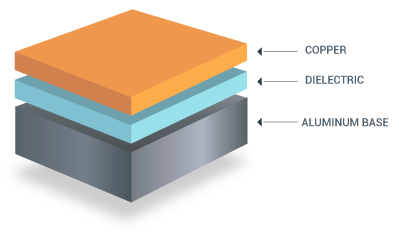 |
It consists of a single copper conductive layer on top, a metal base plate (e.g. Aluminum) to provide rigidness to the circuit board and a thermal conductive dielectric working as the insulator. |
Double Sided Metal Core Stack Up
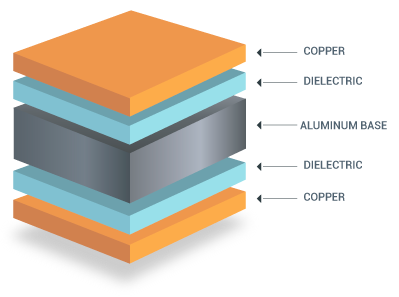 |
It has two copper layers and the metal core is between the copper layers. Plated Through Holes (PTH) are used to interconnect the acopper layers so SMT and THT components can be placed on both sides. |
Multilayer Metal Core PCB Stack Up
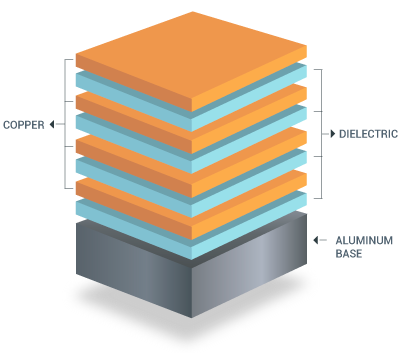 |
It has more than two conductive layers separated by thermal dielectric. In the bottom of the structure is the metal base. SMT components can only be placed on one side. Not THT components are allowed, but it provides the possibility to make blind and buried vias with internal signal layers and power/ground planes. |
MCPCB copper foil thickness can be 1 - 10 oz.
Benefits of Metal Core PCB Fabrication
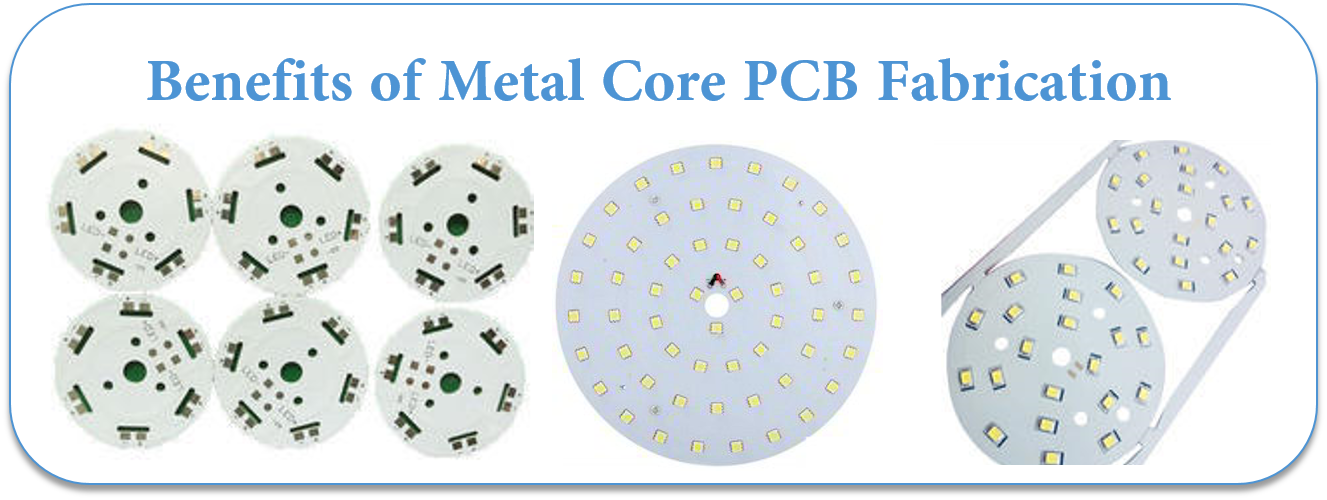
Metal Core PCB Fabrication produces a product that transfers heat up to nine times more rapidly than a typical FR4 PCB. The laminates in MCPCB's dissipate heat which ensures that components which generate heat will remain cooler. This leads to a longer operating life as well as maximized performance for such components.
Applications of Metal Core PCB Fabrication
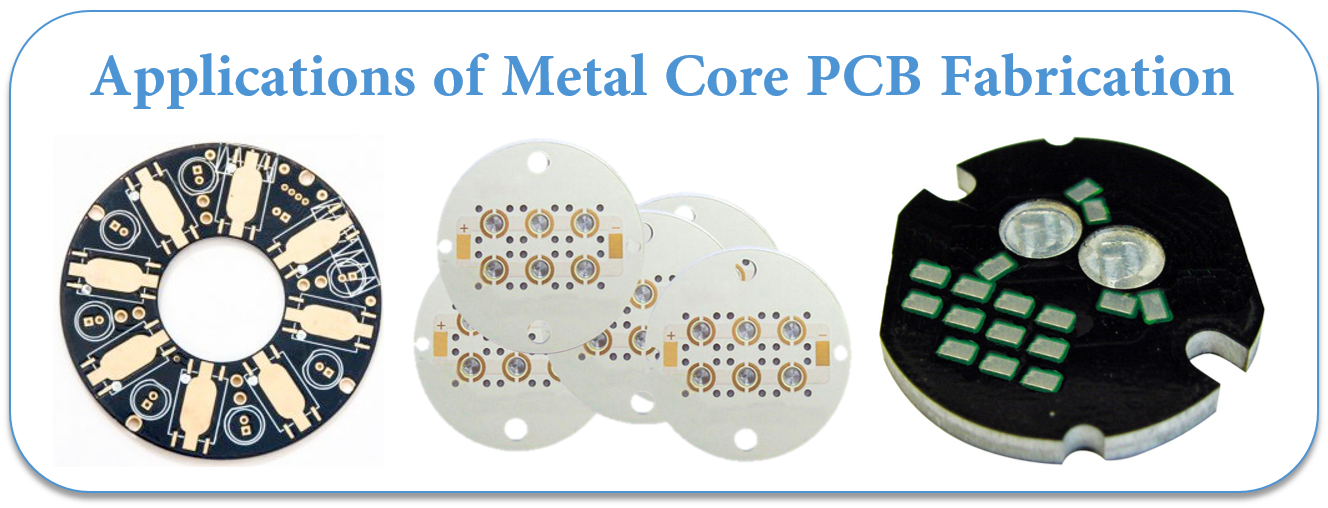
Although LED-based Solid State Light technologies have countless advantages, they inherently produce significant amounts of heat. This makes Metal Core PCB Fabrication helpful for applications like:
LED lights
High-current
LED, Spotlight, high-current PCB
Industrial power equipment
High-power
transistors, transistor arrays, push-pull or totem pole output circuit (to
tem pole), solid-state relay, pulse motor driver, the engine Computing
amplifiers (Operational amplifier for serro-motor), pole-changing device
(Inverter)
Cars
firing
implement, power regulator, exchange converters, power controllers, variable
optical system
Power
voltage
regulator series, switching regulator, DC-DC converters
Audio
input -
output amplifier, balanced amplifier, pre-shield amplifier, audio amplifier,
power amplifier
OA
Printer
driver, large electronic display substrate, thermal print head
Audio
input -
output amplifier, balanced amplifier, pre-shield amplifier, audio amplifier,
power amplifier
Others
Semiconductor
thermal insulation board, IC arrays, resistor arrays, Ics carrier chip, heat
sink, solar cell substrates, semiconductor refrigeration device
Other applications that are ideal for MCPCB integration are solar panels and motion control applications. We can also combine metal core with our HDI PCB technology. We also offer other advanced circuit technology including Flexible PCB Rigid PCB , and Rigid Flex PCB .
Additional information
Metal Core PCB manufacturing process
Metal Core PCB Manufacturing Capability
LED Lighting and MCPCB (Metal Core PCB)
Understanding the Importance of Metal Core PCBs
METAL CORE PCB VS STANDARD CIRCUIT BOARDS
Metal Core PCB is the best source for the heat transformation
Are Metal Core PCBs the Solution to Your Thermal Management Challenges?
Metal Core PCB
Printable Circuit Boards,Metal Core PCB,Metal Core Led PCB,Metal Core PCB Prototype
JingHongYi PCB (HK) Co., Limited , https://www.pcbjhy.com